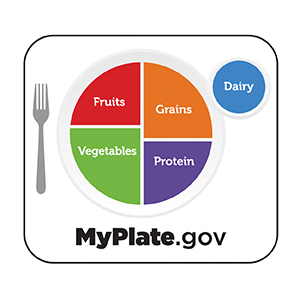Choose MyPlate
One source for sound nutrition advice is the Academy of Nutrition and Dietetics (AND). As a reference for meal planning, the AND recommends MyPlate.gov and the Dietary Guidelines for Americans . Both of these support the “healthy balance” approach that focuses on having nutrient-dense foods and drinks and getting regular physical activity for optimal health.
The MyPlate plan is a guideline to help you eat a healthy diet. It can help you eat a variety of foods while encouraging the right amount of calories and fat. The U.S. Department of Agriculture (USDA) and the U.S. Department of Health and Human Services have prepared the following MyPlate plan to guide you in selecting foods.

MyPlate is divided into five food group categories, emphasizing nutritional intake of the following:
-
Grains. Foods that are made from wheat, rice, oats, cornmeal, barley, or another cereal grain are grain products. Aim for mostly whole grains. Examples include whole-wheat flour, brown rice, and oatmeal.
-
Vegetables. Choose a variety of vegetables, including dark green, red, and orange kinds, legumes (peas and beans), and starchy vegetables. Healthier options to choose from include fresh, canned (low-sodium or no-added-salt versions), or plain frozen vegetables (without added sauces or seasonings).
-
Fruits. Any fruit or 100% fruit juice counts as part of the fruit group. Fruits may be fresh, canned (choose those packed in 100% juice or water), frozen, or dried. Fruit may be whole, cut-up, or pureed. At least half of the fruit you eat should be whole fruit rather than 100% fruit juice.
-
Dairy. Milk products and many foods made from milk are considered part of this food group. Focus on fat-free or low-fat products, as well as those that are high in calcium. Fortified soy milk and yogurt that contain added vitamin A, vitamin D, and calcium are also considered part of the dairy group. This is because the nutrition content is similar to that of dairy milk and yogurt.
-
Protein. Go lean on protein. Choose low-fat or lean meats and poultry. Vary your protein routine. Choose more fish, nuts, seeds, peas, and beans.
Other MyPlate messages
-
Include oils in moderation. Oils are not a food group. But some, such as from nuts, olives, and some fish, contain essential nutrients and should be included in your diet in moderation. Other fats, such as saturated fats, are solid at room temperature and should be avoided. Choosing unsaturated fat in place of saturated fat can reduce your risk of heart disease and improve your HDL or “good” cholesterol.
-
Limit added sugars in your diet. People age 2 and over should choose foods and drinks with little to no added sugars. Children under age 2 should stay away from added sugars altogether. Added sugars are added to foods or drinks when they are processed or prepared. This doesn't include natural sugars found in dairy and fruits.
-
Reduce saturated fats in your diet. A good way to decrease the amount of saturated fats you eat is by replacing foods high in saturated fat with foods high in unsaturated fat. Foods high in saturated fats include butter, whole-fat dairy, cheese, fried foods, and baked goods. Unsaturated fats can be found in some plants and fatty fish, such as olive oil, nuts, avocado, tuna, and salmon.
-
Limit salt (sodium) in your diet. Too much sodium in your diet can increase your blood pressure. Decrease the amount of sodium you eat by flavoring your foods with seasonings and spices instead of salt, making your own food at home instead of dining out or eating frozen foods, and choosing low-sodium or no-salt-added versions of packaged or canned items.
-
If you drink alcohol, do so in moderation. This means 2 drinks or less in a day for men and 1 drink or less in a day for women, on days you consume alcohol. If you don't drink alcohol, you shouldn't start drinking it for any reason.
-
Talk with your healthcare provider. Always consult your healthcare provider regarding your individualized diet requirements.
Online Medical Reviewer:
Bianca Garilli MD
Online Medical Reviewer:
Chris Southard RN
Online Medical Reviewer:
Jessica Gotwals RN BSN MPH
Date Last Reviewed:
8/1/2023
© 2000-2024 The StayWell Company, LLC. All rights reserved. This information is not intended as a substitute for professional medical care. Always follow your healthcare professional's instructions.